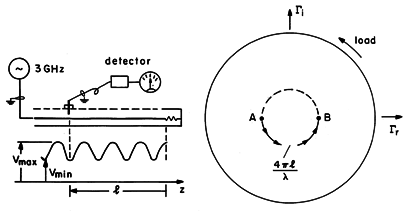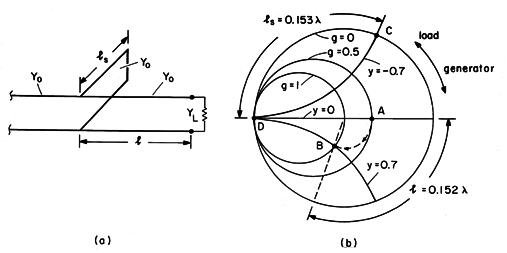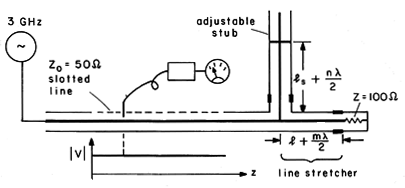In Sec. 14.5, we found that a quarter-wavelength of transmission line turned a short circuit into an open circuit. Indeed, with an appropriate length (or driven at an appropriate frequency), the shorted line could have an inductive or a capacitive reactance. In general, the impedance observed at the terminals of a transmission line has a more complicated dependence on the termination.
Typical microwave measurements are made with a length of transmission line between the observation point and the terminals of the device under study, whether that be an antenna or a transistor. In this section, the objective is a way of visualizing the relation between the impedance at the "generator" terminals and the impedance of the "load." We will find that a representation of the variables in the reflection coefficient plane is valuable both conceptually and practically.
At a location z, the impedance of the transmission line shown in Fig. 14.6.1a is (14.5.10)

where the reflection coefficient at the location z is defined as the complex function

At the load position, where z = 0, the reflection coefficient
is equal to  L as defined by (14.5.11).
L as defined by (14.5.11).
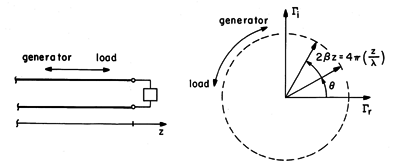
 plane.
plane.
Like the impedance, the reflection coefficient is a function of
z. Unlike the impedance,  has an easily pictured z
dependence. Regardless of z, the magnitude of
has an easily pictured z
dependence. Regardless of z, the magnitude of  is the
same. Thus, as pictured in the complex
is the
same. Thus, as pictured in the complex  plane of Fig.
14.6.1b, it is a complex vector of magnitude |
plane of Fig.
14.6.1b, it is a complex vector of magnitude | -/
-/ +|
and angle
+|
and angle  + 2
+ 2 z, where
z, where  is the angle at the
position z = 0. With z defined as increasing from the
generator to the load, the dependence of the reflection coefficient on
z is as summarized in the figure. As we move from the generator
toward the load, z increases and hence
is the angle at the
position z = 0. With z defined as increasing from the
generator to the load, the dependence of the reflection coefficient on
z is as summarized in the figure. As we move from the generator
toward the load, z increases and hence  rotates in the
counterclockwise direction.
rotates in the
counterclockwise direction.
In summary, once the complex number  is established at one
location z, its variation as we move toward the load or toward the
generator can be pictured as a rotation at constant magnitude in the
counterclockwise or clockwise directions, respectively. Typically,
is established at one
location z, its variation as we move toward the load or toward the
generator can be pictured as a rotation at constant magnitude in the
counterclockwise or clockwise directions, respectively. Typically,
 is established at the location of the load, where the impedance,
ZL, is known. Then
is established at the location of the load, where the impedance,
ZL, is known. Then  at any location z follows from (1)
solved for
at any location z follows from (1)
solved for  .
.

With the magnitude and phase of  established at the load, the
reflection coefficient can be found at another location by a simple
rotation through an angle 4
established at the load, the
reflection coefficient can be found at another location by a simple
rotation through an angle 4 (z/
(z/ ), as shown in Fig. 14.6.1b.
The impedance at this second location would then follow from
evaluation of (1).
), as shown in Fig. 14.6.1b.
The impedance at this second location would then follow from
evaluation of (1).
Smith Chart
We save ourselves the trouble of evaluating (1) or (3), either
to establish  at the load or to infer the impedance implied by
at the load or to infer the impedance implied by
 at some other location, by mapping Z/Zo in the
at some other location, by mapping Z/Zo in the  plane of Fig. 14.6.1b. To this end, we define the normalized
impedance as having a resistive part r and a reactive part x
plane of Fig. 14.6.1b. To this end, we define the normalized
impedance as having a resistive part r and a reactive part x

and plot the contours of constant r and of constant x in the
 plane. This makes it possible to see directly what Z is
implied by each value of
plane. This makes it possible to see directly what Z is
implied by each value of  . Effectively, such a mapping
provides a graphical solution of (1). The next few steps summarize
how this mapping of the contours of constant r and x in the
. Effectively, such a mapping
provides a graphical solution of (1). The next few steps summarize
how this mapping of the contours of constant r and x in the
 r -
r -  i plane can be made with ruler and compass.
i plane can be made with ruler and compass.
First, (1) is written using (4) on the left and  =
=  r +
j
r +
j i on the right. The real and imaginary
parts of this equation must be equal, so it follows that
i on the right. The real and imaginary
parts of this equation must be equal, so it follows that


These expressions are quadratic in  r and
r and  i. By
completing the squares, they can be written as
i. By
completing the squares, they can be written as


Thus, the contours of constant normalized resistance, r, and of constant normalized reactance, x, are the circles shown in Figs. 14.6.2a-14.6.2b.
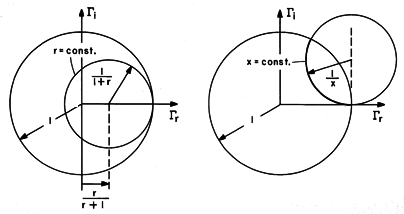
 plane. (b) Circle of constant normalized
reactance, x, in
plane. (b) Circle of constant normalized
reactance, x, in  plane.
plane.
Putting these contours together gives the lines of constant r and x in
the complex  plane shown in Fig. 14.6.3. This is called a
Smith chart.
plane shown in Fig. 14.6.3. This is called a
Smith chart.
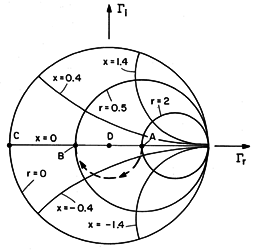
Illustration. Impedance with Simple Terminations
How do we interpret the examples of Sec. 14.5 in terms of the Smith chart?
Quarter-wave Section. In Example 14.5.3 we found that a normalized resistive load rL was transformed into its reciprocal by a quarter-wave line. Suppose that rL = 2 (the load resistance is 2Zo) and x = 0. Then, the load is at A in Fig. 14.6.3. A quarter-wavelength toward the generator is a rotation of 180 degrees in a clockwise direction, with following the trajectory from A
B in Fig. 14.6.3. Note that the impedance at B is indeed the reciprocal of that at A, r = 0.5, x = 0.
Impedance of Short Circuit Line. Consider next the shorted line of Example 14.5.2. The load resistance rL is 0, and reactance xL is 0 as well, so we begin at the point C in Fig. 14.6.3. Now, we can trace out the impedance as we move away from the short toward the generator by rotating along the trajectory of unit radius in the clockwise direction. Note that all along this trajectory, r = 0. The normalized reactance then traces out the values given in Fig. 14.5.2, first taking on positive (inductive) values until it becomes infinite at /4 (rotation of 180 degrees), and then negative (capacitive) values until it returns to C, when the line has a length of
/2.
Matched Line. For the matched load of Example 14.5.1, we start out with rL = 1 and xL = 0. This is point D at the origin in Fig. 14.6.3. Thus, the trajectory of is a circle of zero radius, and the impedance remains rL = 1 over the length of the line.
While taking measurements on a transmission line terminated in a particular device, the Smith chart is often used to have an immediate picture of the impedance at the terminals. Even though the chart could be replaced by a programmable calculator, the overview provided by the Smith chart is important. Not only does it provide insight concerning the impedance, it can be used to picture the spatial evolution of the voltage and current, as we now see.
Standing Wave Ratio
Once the reflection coefficient has been established, the voltage
and current distributions are determined (to within a factor
determined by the source). That is, in terms of  , (14.5.5)
becomes
, (14.5.5)
becomes

The exponential factor has an amplitude that is independent of z.
Thus, [1 +  (z)] represents the z dependence of the voltage
amplitude. This complex quantity can be pictured in the
(z)] represents the z dependence of the voltage
amplitude. This complex quantity can be pictured in the  plane
as shown in Fig. 14.6.4a. Remember, as we move from load to
generator,
plane
as shown in Fig. 14.6.4a. Remember, as we move from load to
generator,  rotates in the clockwise direction. As it does so,
1 +
rotates in the clockwise direction. As it does so,
1 +  varies between a maximum value of 1 + |
varies between a maximum value of 1 + | | and a
minimum value of 1 - |
| and a
minimum value of 1 - | |. According to (9), we can now
picture the spatial distribution of the voltage amplitude.
Convenient for describing this distribution is the voltage
standing wave ratio (VSWR), defined as the ratio of the maximum
voltage amplitude to the minimum voltage amplitude. From Fig.
14.6.4a, we can see that this ratio is
|. According to (9), we can now
picture the spatial distribution of the voltage amplitude.
Convenient for describing this distribution is the voltage
standing wave ratio (VSWR), defined as the ratio of the maximum
voltage amplitude to the minimum voltage amplitude. From Fig.
14.6.4a, we can see that this ratio is

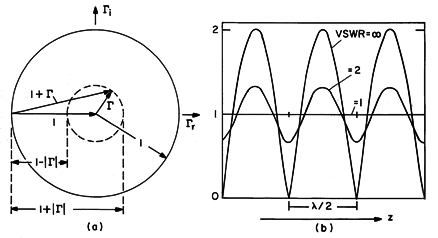
 . (b) Distribution of voltage amplitude for three VSWR's.
. (b) Distribution of voltage amplitude for three VSWR's. The distribution of voltage amplitude is shown for several VSWR's in Fig. 14.6.4b. We have already seen such distributions in two extremes. With the short circuit or open circuit terminations considered in Sec. 13.1, the reflection coefficient was on the unit circle and the VSWR was infinite. Indeed, the infinite VSWR envelope of Fig. 14.6.4b is that of a standing wave, with nulls every half-wavelength. The opposite extreme is also familiar. Here, the line is matched and the reflection coefficient is on a circle of zero radius. Thus, the VSWR is unity and the distribution of voltage amplitude is uniform.
Measurement of the VSWR and the location of a voltage null provides the information needed to determine a line termination. This follows by first using (10) to evaluate the magnitude of the reflection coefficient from the measured VSWR.

Thus, the radius of the circle representing the voltage distribution
on the line has been determined. Second, a determination of the
position of a null is tantamount to locating (to within a
half-wavelength) the position on the line where  passes
through the negative real axis. The distance from this point to the
load, in wavelengths, then determines where the load is located on
this circle. The corresponding impedance is that of the load.
passes
through the negative real axis. The distance from this point to the
load, in wavelengths, then determines where the load is located on
this circle. The corresponding impedance is that of the load.
Demonstration 14.6.1. VSWR and Load Impedance
In the slotted line shown in Fig. 14.6.5, a movable probe with its attached detector provides a measure of the line voltage as a function of z. The distance between the load and the voltage probe can be measured directly. By using a frequency of 3 GHz and an air-insulated cable (having a permittivity that is essentially that of free space, so that the wave velocity is 3 x 108 m/s), the wavelength is conveniently 10 cm.
Fig 14.6.5 Demonstration of distribution of voltage magnitude as function of VSWR. The characteristic impedance of the coaxial cable is 50
, so with terminations of 50
, 100
, and a short, the observed distribution of voltage is as shown in Fig. 14.6.4b for VSWR's of 1, 2, and
. (To plot data points on these curves, the measured values should be normalized to match the peak voltage of the appropriate distribution.)
Figure 14.6.5 illustrates how a measurement of the VSWR and position of a null can be used to infer the termination. Addition of a half-wavelength to l means an additional revolution in the
plane, so which null is used to define the distance l makes no difference. The trajectory drawn in the illustration is for the 100
termination.
Admittance in the Reflection Coefficient Plane
Commonly, transmission lines are interconnected in parallel. It is then convenient to work with the admittance rather than the impedance. The Smith chart describes equally well the evolution of the admittance with z.
With Yo = 1/Zo defined as the characteristic admittance, it follows from (1) that

If 
 -
- , this expression becomes identical to
that relating the normalized impedance to
, this expression becomes identical to
that relating the normalized impedance to  , (1). Thus, the
contours of constant normalized conductance, g, and normalized
susceptance, y,
, (1). Thus, the
contours of constant normalized conductance, g, and normalized
susceptance, y,

are those of the normalized impedance, r and x, rotated by 180 degrees. Rotate by 180 degrees the impedance form of the Smith chart and the admittance form is obtained! The contours of r and x, respectively, become those of g and y.


